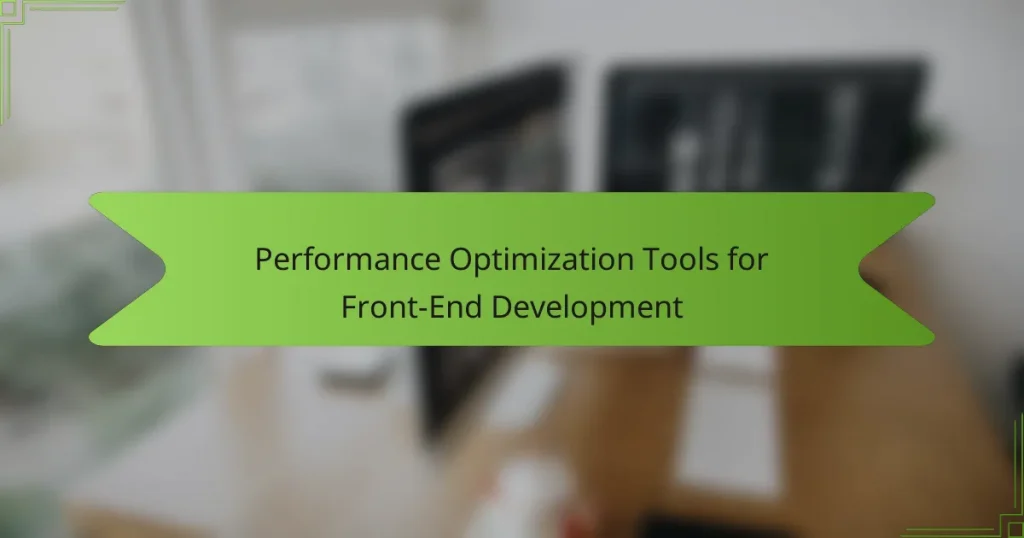Performance optimization tools for front-end development enhance the speed and efficiency of web applications by analyzing load times, resource usage, and rendering speed. Key tools include Google PageSpeed Insights, which provides actionable performance suggestions, WebPageTest for detailed load performance insights, and Lighthouse for auditing performance, accessibility, and SEO. Optimizing performance is essential as it directly impacts user experience, engagement, and conversion rates, while also improving search engine rankings and reducing server load. Developers can effectively implement these tools by integrating them into their workflow, prioritizing performance issues, and utilizing automated testing and browser developer tools for ongoing analysis. Continuous education on optimization techniques is vital for maintaining high performance standards.

What are Performance Optimization Tools for Front-End Development?
Performance optimization tools for front-end development are software applications designed to enhance the speed and efficiency of web applications. These tools analyze various aspects of web performance, including load times, resource usage, and rendering speed. Examples include Google PageSpeed Insights, which evaluates page performance and provides actionable suggestions. Another tool is WebPageTest, which offers detailed insights into load performance and bottlenecks. Lighthouse is also popular; it audits performance, accessibility, and SEO. These tools help developers identify issues and implement improvements that lead to a better user experience. Studies show that faster-loading sites can significantly increase user engagement and conversion rates.
How do these tools enhance the performance of web applications?
Performance optimization tools enhance the performance of web applications by improving loading speeds and reducing resource consumption. These tools achieve this through techniques such as minification, which reduces file sizes by removing unnecessary characters. They also implement caching strategies that store frequently accessed data, decreasing server requests. Additionally, these tools can analyze and identify bottlenecks in code, allowing for targeted improvements. For example, tools like Google PageSpeed Insights provide actionable recommendations to optimize images and scripts. By leveraging these suggestions, developers can significantly enhance user experience and engagement. Studies show that faster loading times correlate with higher user retention rates, making these tools essential for effective web development.
What key metrics do these tools measure?
Performance optimization tools for front-end development measure several key metrics. These metrics include page load time, which indicates how quickly a webpage becomes interactive. Another important metric is Time to First Byte (TTFB), measuring the responsiveness of a web server. Additionally, tools assess First Contentful Paint (FCP), which tracks when the first piece of content is rendered on the screen. They also evaluate Speed Index, reflecting how quickly visible parts of a page are displayed. Other metrics include total blocking time, which gauges how long a page is unresponsive, and cumulative layout shift, measuring visual stability during loading. These metrics provide insights into user experience and overall performance efficiency.
How do these metrics influence user experience?
Metrics directly influence user experience by determining how quickly and efficiently a website performs. Key metrics include load time, responsiveness, and interactivity. Faster load times lead to lower bounce rates and higher user engagement. A study by Google found that a one-second delay in load time can reduce conversions by 20%. Responsiveness affects how users perceive a website’s usability. Metrics like Time to First Byte (TTFB) and First Contentful Paint (FCP) are critical for assessing responsiveness. Improved interactivity enhances user satisfaction and encourages return visits. Overall, these metrics are essential for creating a positive user experience and optimizing performance.
What types of performance optimization tools are available?
Performance optimization tools for front-end development include various types designed to enhance website speed and efficiency. These tools can be categorized into performance testing tools, such as Google Lighthouse and WebPageTest, which analyze site performance metrics. Additionally, there are code optimization tools like UglifyJS and CSSNano that minimize file sizes. Browser developer tools, available in Chrome and Firefox, offer built-in features for real-time performance monitoring. Content Delivery Network (CDN) services, such as Cloudflare, improve load times by distributing content geographically. Finally, monitoring tools like New Relic and GTmetrix provide insights into performance over time. Each of these tools plays a crucial role in ensuring optimal front-end performance.
What are the differences between front-end and back-end optimization tools?
Front-end optimization tools focus on improving the user interface and experience of a website. They enhance aspects like loading speed, visual performance, and responsiveness. Common tools include image compressors, CSS and JavaScript minifiers, and content delivery networks (CDNs). These tools help in reducing file sizes and improving page load times.
Back-end optimization tools target server-side performance and database efficiency. They optimize server response times, database queries, and application logic. Examples include caching solutions, database optimizers, and server monitoring tools. These tools ensure that the server processes requests quickly and efficiently.
In summary, front-end tools enhance user experience, while back-end tools improve server performance. This distinction is crucial for comprehensive website optimization.
How do browser developer tools contribute to performance optimization?
Browser developer tools significantly enhance performance optimization. They provide real-time insights into website behavior. Developers can analyze loading times, resource sizes, and rendering performance. Tools like the Network panel reveal how long each resource takes to load. The Performance panel allows for detailed profiling of JavaScript execution. These insights help identify bottlenecks and inefficient code. Additionally, tools offer suggestions for optimizing assets. For example, they may recommend image compression or code minification. By utilizing these features, developers can create faster, more efficient web applications.

Why is performance optimization crucial in front-end development?
Performance optimization is crucial in front-end development because it directly affects user experience. Faster loading times lead to higher user satisfaction and retention rates. Studies show that a one-second delay in page load can reduce conversions by 7%. Additionally, optimized performance improves search engine rankings. Google prioritizes fast-loading sites in its search results. This can lead to increased visibility and traffic. Furthermore, performance optimization reduces server load, leading to cost savings. Efficient code and resources decrease bandwidth usage. Overall, performance optimization enhances usability, accessibility, and overall effectiveness of web applications.
What impact does website performance have on user engagement?
Website performance significantly impacts user engagement. Faster loading times enhance user satisfaction. According to Google, 53% of mobile users abandon sites that take over three seconds to load. Improved performance reduces bounce rates and increases time spent on the site. A study by Akamai found that a one-second delay in page load time can lead to a 7% reduction in conversions. Additionally, users are more likely to return to a site that performs well. Enhanced performance fosters a positive user experience, encouraging interaction and loyalty. Overall, optimizing website performance is crucial for maximizing user engagement.
How does loading speed affect bounce rates?
Loading speed significantly affects bounce rates. A slow-loading website leads to higher bounce rates because users tend to leave if a page takes too long to load. Studies show that a delay of just one second can decrease customer satisfaction by 16%. Furthermore, Google found that 53% of mobile site visits are abandoned if a page takes longer than three seconds to load. This correlation indicates that faster loading speeds enhance user experience and reduce bounce rates. Therefore, optimizing loading speed is crucial for retaining visitors.
What role does mobile optimization play in user retention?
Mobile optimization significantly enhances user retention by improving user experience on mobile devices. A well-optimized mobile site loads faster, which is crucial as 53% of mobile users abandon sites that take over three seconds to load. Additionally, mobile optimization ensures that content is easily accessible and navigable, leading to increased user satisfaction. Research indicates that 70% of mobile users return to websites that are mobile-friendly. Furthermore, optimized sites reduce bounce rates, keeping users engaged for longer periods. This engagement translates into higher retention rates, as users are more likely to return to a site that meets their mobile needs effectively.
What are the common challenges in performance optimization?
Common challenges in performance optimization include identifying bottlenecks, managing resource loading, and ensuring cross-browser compatibility. Bottlenecks can arise from inefficient code or heavy assets, which slow down application performance. Managing resource loading involves optimizing scripts and stylesheets to reduce load times. Cross-browser compatibility issues can lead to inconsistent performance across different browsers. Additionally, measuring performance accurately can be difficult without the right tools. Keeping up with evolving web standards and best practices also presents a challenge. These factors collectively hinder effective performance optimization in front-end development.
How can developers identify performance bottlenecks?
Developers can identify performance bottlenecks by using profiling tools. Profiling tools analyze application performance and detect slow components. Tools like Chrome DevTools, Lighthouse, and WebPageTest provide insights into load times and resource usage. These tools can pinpoint which scripts or assets are causing delays. Developers can also utilize network monitoring tools to track API response times. Analyzing the performance metrics helps in understanding where optimizations are needed. Regular testing during development can reveal issues early. Performance audits can also highlight areas for improvement.
What strategies can be employed to overcome these challenges?
Utilizing performance optimization tools effectively can help overcome challenges in front-end development. Implementing code splitting reduces the initial load time by breaking up large bundles into smaller chunks. Leveraging lazy loading ensures that images and resources load only when they are in the viewport, improving perceived performance. Employing browser caching can enhance load times for repeat visitors by storing static assets locally. Using Content Delivery Networks (CDNs) distributes content closer to users, decreasing latency. Optimizing images through compression and appropriate formats reduces file sizes without sacrificing quality. Analyzing performance metrics with tools like Google Lighthouse provides insights for ongoing improvements. Regularly auditing dependencies ensures that only necessary libraries are included, minimizing bloat. These strategies collectively enhance user experience and application performance.

How can developers implement performance optimization tools effectively?
Developers can implement performance optimization tools effectively by integrating them into their development workflow. First, they should identify key performance metrics relevant to their applications. Tools like Google Lighthouse can help assess these metrics. Next, developers should prioritize the issues identified in performance audits. Addressing critical issues first can lead to significant improvements.
Additionally, incorporating automated performance testing in the CI/CD pipeline ensures consistent monitoring. Tools such as WebPageTest provide detailed insights into loading times and resource usage. Developers should also leverage browser developer tools for real-time performance analysis. Regularly reviewing and updating dependencies can prevent performance bottlenecks.
Finally, continuous education on emerging optimization techniques is essential for maintaining performance standards. According to a study by the Google Web Fundamentals team, optimizing performance can lead to a 20% increase in user engagement.
What best practices should developers follow when using these tools?
Developers should follow several best practices when using performance optimization tools for front-end development. First, they should regularly analyze their code for performance bottlenecks. Tools like Google Lighthouse can help identify issues such as large image sizes or excessive JavaScript.
Second, developers should prioritize critical rendering paths. This means optimizing the order and method by which resources are loaded. For instance, using asynchronous loading for non-critical scripts can improve page load times.
Third, developers should minimize HTTP requests by combining files where possible. Fewer requests lead to faster load times.
Fourth, they should leverage browser caching to store frequently accessed resources. This practice reduces load times for returning visitors.
Fifth, developers should stay updated with the latest best practices and tools. Resources like the Web Performance Working Group offer valuable insights.
By adhering to these practices, developers can significantly enhance the performance of their front-end applications.
How can regular performance audits improve web applications?
Regular performance audits can significantly enhance web applications by identifying bottlenecks and inefficiencies. These audits assess various performance metrics such as load times, responsiveness, and resource usage. By pinpointing areas that require optimization, developers can implement targeted improvements. For instance, optimizing images and scripts can reduce load times by up to 80%. Regular audits also help maintain compliance with best practices, ensuring a consistent user experience. Furthermore, they provide insights into user behavior, allowing for informed decisions on feature prioritization. Overall, consistent performance evaluations lead to improved functionality and user satisfaction.
What tools can assist in automating performance optimization tasks?
Tools that can assist in automating performance optimization tasks include Google PageSpeed Insights, GTmetrix, and WebPageTest. Google PageSpeed Insights analyzes web pages and provides suggestions for improving performance. GTmetrix offers detailed reports on page speed and performance metrics. WebPageTest allows users to run performance tests from various locations and browsers. These tools provide actionable insights to enhance website load times and user experience. They are widely used in the industry, supporting developers in achieving optimal performance.
What are the common pitfalls to avoid in front-end performance optimization?
Common pitfalls to avoid in front-end performance optimization include neglecting image optimization. Unoptimized images can significantly slow down page load times. Another pitfall is excessive use of JavaScript. Heavy scripts can block rendering and degrade performance. Failing to leverage browser caching is also a mistake. Without caching, users will need to reload resources unnecessarily.
Additionally, not minifying CSS and JavaScript files can lead to larger file sizes. Larger files take longer to download and execute. Overloading the critical rendering path is another issue. This can delay the time it takes for a page to become interactive. Lastly, ignoring performance testing tools can prevent identification of bottlenecks. Tools like Google Lighthouse can provide valuable insights for improvement.
How can misconfigurations lead to performance issues?
Misconfigurations can lead to performance issues by causing inefficient resource allocation. When settings are incorrectly defined, it can result in excessive memory usage. This may slow down application response times. Misconfigured caching settings can lead to unnecessary data retrieval from servers. This increases load times and impacts user experience. Network configurations can also cause bottlenecks, affecting data transfer speeds. Additionally, improper database configurations can lead to slow queries. According to a study by Google, 53% of mobile users abandon sites that take over three seconds to load. This highlights the importance of correct configurations for optimal performance.
What misconceptions about performance optimization should developers be aware of?
Developers should be aware that performance optimization is not solely about code minification. Many believe that reducing file sizes automatically improves load times. However, network latency and server response times also significantly impact performance. Another misconception is that performance optimization is a one-time task. In reality, it requires continuous monitoring and adjustment as applications evolve. Additionally, some think that only front-end optimizations matter. Back-end performance also plays a crucial role in overall application speed. Lastly, there is a belief that more tools guarantee better performance. Effective optimization often relies on understanding the specific needs of the application rather than just using multiple tools.
What practical tips can enhance front-end performance optimization?
Minimizing HTTP requests enhances front-end performance optimization. Fewer requests reduce load time. Combining CSS and JavaScript files can achieve this. Using image sprites also minimizes requests for images.
Optimizing images is another crucial tip. Compressing images decreases their file size without losing quality. Tools like ImageOptim can help with this process.
Implementing lazy loading improves performance further. This technique loads images only when they enter the viewport. It reduces initial load time significantly.
Utilizing browser caching is effective for returning visitors. Setting appropriate cache headers allows browsers to store files locally. This reduces the need to fetch resources repeatedly.
Minifying CSS, JavaScript, and HTML files is essential. Removing unnecessary characters decreases file size. Tools like UglifyJS can automate this process.
Using a Content Delivery Network (CDN) can speed up content delivery. CDNs store copies of your site in multiple locations. This reduces latency by serving content from the nearest location.
Lastly, reducing the use of render-blocking resources is important. Prioritize loading essential scripts and styles first. This allows the page to display content faster.
Performance optimization tools for front-end development are essential software applications that enhance the speed and efficiency of web applications by analyzing load times, resource usage, and rendering speed. This article covers various types of these tools, including performance testing tools like Google PageSpeed Insights and WebPageTest, and discusses key metrics such as page load time and Time to First Byte (TTFB) that influence user experience. It also highlights the importance of mobile optimization, common challenges developers face, and strategies for effectively implementing these tools to improve overall website performance and user engagement. Regular performance audits and best practices for using these tools are emphasized to ensure continuous optimization and better user satisfaction.


